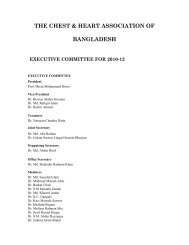Volume. 35, No. 2 july. 2011 - The Chest and Heart Association of ...
Volume. 35, No. 2 july. 2011 - The Chest and Heart Association of ...
Volume. 35, No. 2 july. 2011 - The Chest and Heart Association of ...
You also want an ePaper? Increase the reach of your titles
YUMPU automatically turns print PDFs into web optimized ePapers that Google loves.
Incorporating Omalizumab into Asthma Management: A ReviewMd. Khairul Hassan Jessy et al.department, <strong>and</strong> a reduced quality <strong>of</strong> life. As aresult, patients <strong>and</strong> their family members haveboth personal <strong>and</strong> economic hardship. From theperspective <strong>of</strong> public <strong>and</strong> societal health,approximately 17 million people in the UnitedStates have been estimated to have asthma, onethird <strong>of</strong> them children. Asthma in the United Statescosts an estimated $12.7 billion annually, withmost <strong>of</strong> this cost attributable to direct medicalexpenditures <strong>and</strong> medication. 3IgE plays a central role in the pathophysiology <strong>of</strong>asthma. <strong>The</strong> two essential phases in thispathophysiology are sensitization to allergen <strong>and</strong>clinical expression <strong>of</strong> symptoms on re-exposure tothe sensitizing allergen. During sensitization,inhaled antigen (i.e., aeroallergen) is taken up byantigen-presenting dendritic cells lining theairways. <strong>The</strong> allergen is then processed <strong>and</strong>presented to antigen-specific T cells. In somepersons, these T cells respond by producingcytokines that stimulate the development <strong>of</strong> IgEproducingB cells. <strong>The</strong> Fc portion <strong>of</strong> circulatingIgE then binds to high-affinity receptors (FcåRIs)present on the surfaces <strong>of</strong> mast cells <strong>and</strong>basophils. 4,5,6 On re-exposure, the sensitizingallergen cross-links IgE molecules present on mastcell<strong>and</strong> basophil surfaces. This initiatesdegranulation <strong>and</strong> the release <strong>of</strong> inflammatorymediators, including histamine, prostagl<strong>and</strong>ins,leukotrienes, chemokines, <strong>and</strong> cytokines. <strong>The</strong>semediators precipitate an immediate acute-phasereaction, resulting in acute bronchospasm,expressed clinically as an episode <strong>of</strong> acute asthma.Continued expression <strong>of</strong> mediators enlists aninflammatory response designated the late-phasereaction, which causes persistent symptoms,airway hyper-responsiveness, <strong>and</strong> bronchospasm.IgE may also facilitate sensitization to allergens.Dendritic cells express FcåRIs <strong>and</strong> have been foundto bind IgE, which is thought to focus antigen atthe cell surface. In addition IgE binds to low affinityFCe receptors on B cells, which it altersdifferentiation <strong>and</strong> regulation <strong>of</strong> further IgEsynthesis. 3,4Unmet Needs: Barriers to ImprovedOutcomesPatients with the greatest unmet needs are thosewith moderate-to-severe asthma that is suboptimallycontrolled. <strong>The</strong>se patients remainsymptomatic despite the use <strong>of</strong> multiplemedications. <strong>The</strong> hallmark feature <strong>of</strong> thesepatients is frequent, severe exacerbations that<strong>of</strong>ten require costly emergency treatment,hospitalization, or both. 7,8 This observationsupports the theory that current therapies areunderused, are used inappropriately, or are notconsistently effective. 9 <strong>The</strong> Epidemiology <strong>and</strong>Natural History <strong>of</strong> Asthma Outcomes <strong>and</strong>Treatment Regimen (TENOR) Study was initiatedto describe the natural history <strong>of</strong> asthma patients,to elucidate the relationship between IgE <strong>and</strong>disease, <strong>and</strong> to examine the relationship betweenseverity <strong>of</strong> asthma, its treatment, <strong>and</strong> clinicaloutcomes. 8,9Emerging Asthma <strong>The</strong>rapiesOmalizumab is a recombinant humanized IgG1monoclonal anti-IgE antibody that binds to the IgEmolecule at the same epitome on the Fact regionthat binds to FcåRI. 4,5 This design means thatOmalizumab is not anaphylactogenic, since itcannot interact with IgE that is already bound tocell surfaces <strong>and</strong> thus cannot induce degranulation<strong>of</strong> mast cells or basophils. 4,5 Instead, Omalizumabbinds to circulating IgE, regardless <strong>of</strong> allergenspecificity, forming small, biologically inert IgE–anti-IgE complexes without activating thecomplement cascade. 3,4,5 An 89 to 99% reductionin free serum IgE (i.e., IgE not bound toOmalizumab) occurs soon after the administration<strong>of</strong> Omalizumab, <strong>and</strong> low levels persist throughouttreatment with appropriate doses. Pro<strong>of</strong>-<strong>of</strong>-conceptstudies have shown that Omalizumab reduces bothearly- <strong>and</strong> late-phase asthmatic responses afterallergen inhalation challenge, has a marked effecton late-phase as compared with early-phase skinresponses, decreases eosinophil numbers insputum <strong>and</strong> submucosal bronchial specimens, <strong>and</strong>also down-regulates FcåRI on basophils, mast cells,<strong>and</strong> dendritic cells. A reduction in the expression<strong>of</strong> FcåRI on basophils <strong>and</strong> mast cells decreases thebinding <strong>of</strong> circulating IgE, thus preventing therelease <strong>of</strong> inflammatory mediators. A reduction inthe expression <strong>of</strong> FcåRI on dendritic cells maydecrease allergen processing <strong>and</strong> presentation.Evidence <strong>of</strong> Clinical Benefit<strong>The</strong>re are four core r<strong>and</strong>omized, double-blindclinical trials that have compared Omalizumab,administered subcutaneously, with placebo. In121



